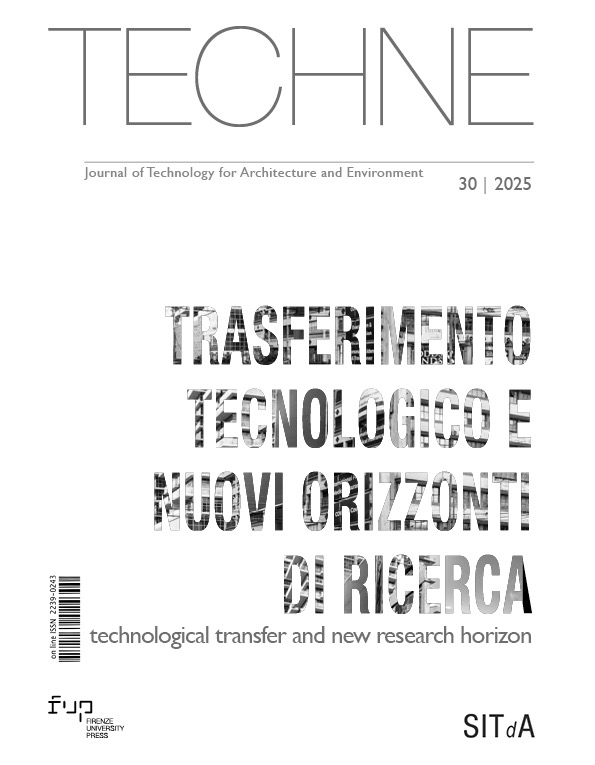Extended partnership and knowledge sharing: the RETURN Urban Living Lab approach to social-ecological-technological innovation
Published 2025-11-07
Keywords
- Knowledge sharing,
- Building renovation
How to Cite
Copyright (c) 2025 Maria Fabrizia Clemente, Bruna Vendemmia, Libera Amenta

This work is licensed under a Creative Commons Attribution 4.0 International License.
Abstract
The RETURN Extended Partnership aims to produce and share knowledge about environmental, natural and anthropogenic risks by promoting the active and proactive involvement of several interdisciplinary research groups, industrial partners and stakeholders. Against this scenario, the activities of Spoke TS1-Urban and Metropolitan Settlements included, among many initiatives, the activation of a series of workshops on the Urban Living Lab model in the Site of National Interest of Bagnoli-Coroglio aimed at sharing knowledge and experiencing processes of co-exploration, co-design and co-testing. The objective of the workshops organised according to the Urban Living Lab methodology is to develop cognitive and operational processes in which the technical approach enables the integration of socio-cultural and ecological-biophysical dimensions in the design processes.
Downloads
References
- Ahmadov, T., Karimov, A., Durst, S., Saarela, M., Gerstlberger, W., Wahl, M. F., and Karkkainen, T. (2024), “A two-phase systematic literature review on the use of serious games for sustainable environmental education”, Interactive Learning Environments, pp. 1-22. DOI: https://doi.org/10.1080/10494820.2024.2414429
- Baibarac, C. and Petrescu, D. (2019), Co-design and urban resilience: visioning tools for commoning resilience practices. CoDesign.
- Conti, G., Grimaldi, R. and Hockaday, T. (2024), Knowledge Share: the (R) evolution of Technology Transfer. Springer Nature Switzerland, Imprint: Springer. DOI: https://doi.org/10.1007/978-3-031-51384-8
- De Jans, S., Van Geit, K., Cauberghe, V., Hudders, L. and De Veirman, M. (2017), “Using games to raise awareness: How to co-design serious mini-games?”, Computers & Education, Vol. 110, pp. 77-87. DOI: https://doi.org/10.1016/j.compedu.2017.03.009
- Ebbesson, E., Lund, J., Smith, R.C. (2024), “Dynamics of sustained co-design in Urban Living Labs”, CoDesign, Vol. 20, n. 3, pp. 422-439. Available at: https://doi.org/10.1080/15710882.2024.2303115. DOI: https://doi.org/10.1080/15710882.2024.2303115
- Engez, A., Leminen, S. and Aarikka-Stenroos, L. (2021), “Urban Living Lab as a Circular Economy Ecosystem: Advancing Environmental Sustainability through Economic Value, Material, and Knowledge Flows”, Sustainability, Vol. 13, n. 5, p. 2811. Available at: https://doi.org/10.3390/su13052811. DOI: https://doi.org/10.3390/su13052811
- Fanzini, D., Venturini, G., Rotaru, I. ., Parrinello, C. and De Cocinis, A. (2020), “Placemaking for the regeneration of the Costanzo Ciano neighbourhood in Piacenza”, TECHNE – Journal of Technology for Architecture and Environment, Vol. 19, pp. 213–222. Available at: https://doi.org/10.13128/techne-7830.
- Hamari J. & Koivisto J. and Sarsa H. (2014), “Does Gamification Work? – A Literature Review of Empirical Studies on Gamification”, in Proceedings of the Annual Hawaii International Conference on System Sciences. Available at: https://doi.org/10.1109/HICSS.2014.377. DOI: https://doi.org/10.1109/HICSS.2014.377
- Hossain, M., Leminen, S. and Westerlund, M. (2019), “A systematic review of living lab literature”, Journal of cleaner production, Vol. 213, pp. 976-988. Available at: https://doi.org/10.1016/j.jclepro.2018.12.257 DOI: https://doi.org/10.1016/j.jclepro.2018.12.257
- Jenkins, S.C., Lachlan, R.F. and Osman, M. (2024), “An integrative framework for mapping the psychological landscape of risk perception”, Sci Rep, Vol. 14, p. 10989. Available at: https://doi.org/10.1038/s41598-024-59189-y. DOI: https://doi.org/10.1038/s41598-024-59189-y
- JPI Urban Europe (2013), Urban Living Labs: Experimenting with city futures. Available at: https://jpi-urbaneurope.eu.
- Losasso, M., Attaianese, E. and Rigillo, M. (Eds) (2024), Innovazioni Convergenti per lo spazio abitabile, Clean edizioni, Napoli.
- Losasso, M. (2020), “Processi innovativi per l’adattamento climatico nella rigenerazione dei distretti urbani/ Innovating Processes for Climate Adaptation in Urban District Regeneration” in Losasso, M., Lucarelli, M.T., Rigillo, M., Valente, R. (a cura di), Adattarsi al clima che cambia, Collana Studi e Progetti, Maggioli Editore, Santarcangelo di Romagna (RN), pp. 9-14.
- Marciano, C., Peresan, A., Pirni, A., Pittore, M., Tocchi, G. and Zaccaria, A. M. (2024), “A Participatory Foresight Approach in Disaster Risk Management: The Multi-Risk Storylines”, International Journal of Disaster Risk Reduction, p. 104972. Available at: https://doi.org/10.1016/j.ijdrr.2024.104972 DOI: https://doi.org/10.1016/j.ijdrr.2024.104972
- McPhearson, T., Cook, E.M., Berbés-Blázquez, M., Cheng, C., Grimm, N.B., Andersson, E. et al., (2022), “A social-ecological-technological systems framework for urban ecosystem services”, One Earth, Vol. 5, n. 5, pp. 505-518. Available at: https://doi.org/10.1016/j.oneear.2022.04.007. DOI: https://doi.org/10.1016/j.oneear.2022.04.007
- Paskaleva, K. and Cooper, I. (2021), “Are living labs effective? Exploring the evidence”, Technovation, Vol. 106, p. 102311. Available at: https://doi.org/10.1016/j.technovation.2021.102311. DOI: https://doi.org/10.1016/j.technovation.2021.102311
- Perriccioli, M. (2017), “Innovazione sociale e cultura del progetto”, TECHNE – Journal of Technology for Architecture and Environment, Vol. 14, Firenze University Press, pp. 25-31.
- REPAiR (2017), PULLs Handbook REPAiR Deliverable 5.1 EU Commission Participant portal. Brussels. Grant Agreement No 688920. Available at: https://doi.org/10.4233/uuid:321f152a-0fe7-4125-bb98-c8c253e5b3.
- Schweizer, P. J., Goble,R., and Renn, O. (2022), “Social Perception of Systemic Risks”, Risk Analysis, Vol. 42, No. 7. Available at: 10.1111/risa.13831. DOI: https://doi.org/10.1111/risa.13831
- Scolobig, A., Komendantova, N., and Mignan, A. (2017), “Mainstreaming Multi-Risk Approaches into Policy”, Geosciences, Vol. 7, n. 4, p. 129. Available at: https://doi.org/10.3390/geosciences7040129. DOI: https://doi.org/10.3390/geosciences7040129
- Steen, K. and Van Bueren, E. (2017), Urban Living Labs: A living lab way of working.
- Trogrlić, R. Š., Reiter, K., Ciurean, R. L., Gottardo, S., Torresan, S., Daloz, A. S., … and Ward, P. J. (2024), “Challenges in assessing and managing multi-hazard risks: A European stakeholders perspective”, Environmental Science & Policy, Vol. 157, p. 103774. Available at: https://doi.org/10.1016/j.envsci.2024.103774. DOI: https://doi.org/10.1016/j.envsci.2024.103774
- Zamenopoulos, T. and Alexiou, K. (2018), Co-design as collaborative research. Bristol University/AHRC Connected Communities Programme.






